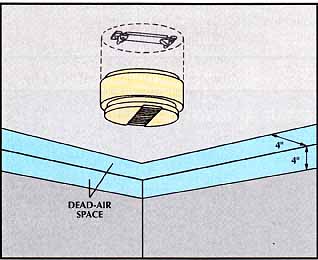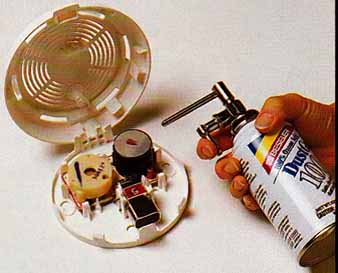Building and electrical codes make new houses relatively fireproof. Yet no home possesses all the features that can reduce the chance of fire, slow its spread, and en sure escape should fire break out. Taking the steps on the following pages—hanging flame-retarding wallboard, adding firestops, and installing smoke detectors and fire extinguishers—can fill fire-safety chinks that codes don’t often address.
- Smoke Detectors
- Ways to Make a House Hard to Burn
- Building Walls That Resist Flames
- Portable Extinguishers for Small Fires
- Ladders to Escape a House Fire
Smoke Detectors
Although they are small and in expensive, smoke detectors can play a priceless protective role. If properly located, they will sound an alarm early enough to enable you to escape from a fire.
Different Sensing Methods: Smoke detectors come in two forms: In a chamber of the ionization type of detector, electrically charged particles flood a gap between two terminals. Normally the particles carry current, but smoke from a fire disrupts the flow and triggers the alarm. In a photoelectric detector, the alarm is tripped when smoke deflects a beam of light onto a light-sensitive switch.
Ionization detectors respond quickly to smoke from clean-burning fires of paper and wood. However, they tend to sound false alarms when exposed to ordinary household fumes and kitchen smoke.
Photoelectric detectors respond slowly to clean-burning fires but quickly to the slow-burning, smoldering fires that occur most frequently in houses—those that produce heavy smoke and are most likely to start in a kitchen, base- merit, bedroom, or living room.
Battery Backup: Although some detectors operate on the house’s electrical current, many models are battery powered and can be installed without difficulty wherever you need them. They also continue to provide protection in the event of a power failure— a likely occurrence in an electrical fire. If your house has hard- wired detectors that lack battery backup, install battery-powered ones next to them.
Most detectors sound a beep when the battery runs low. Even if no low-battery indicator sounds, change the batteries once a year. (An easy-to-remember system is to replace them every autumn when you set back the clock from daylight-saving time.) If you move into a new house or apartment, replace all the batteries at once.
86 Locating detectors in a house. Since most fatal fires occur at night, install detectors in hallways outside bedrooms. Some smoke detectors also contain heat sensors, which are useful in furnace rooms, where a rapid rise in temperature can occur before fire breaks out. Install at least one detector on every floor. Set one at the head of a stairwell. Place additional detectors in rooms where fires commonly start; in a kitchen, use a photoelectric model, which will not react to normal cooking fumes. Install extra detectors ac cording to a household’s particular circum stances—for example, directly over a sleeping area if that person smokes in bed.
Some communities strictly regulate the placement of smoke detectors. Check with local fire authorities for any special requirements.

Locating a detector in a room. Wherever possible,
place a smoke detector at the center of the ceiling. If this location is
not practical, observe the following guidelines to avoid dead-air spaces
in which the smoke from a fire is unlikely to circulate and a detector will
be ineffective:
In most rooms, install a ceiling-mounted detector at least 4 inches from a wall; place a wall-mounted unit no less than 4 inches from the ceiling. In rooms with cathedral or A-frame ceilings, position the smoke detector about 12 inches below the peak of the ceiling. On a beamed ceiling, install the detector on the bottom of a beam, not in the space between beams.

Testing and Maintaining Detectors: Test smoke detectors
once a month. Push the test button on a photoelectric model, and test ionization
detectors with special aerosol sprays designed for this purpose. If the alarm
fails to sound, try a fresh battery. If it still fails, re place the entire
detector.
An occasional cleaning prevents dust buildups that can cause a detector to malfunction or to sound false alarms. The upholstery nozzle of a vacuum cleaner is ideal for removing dust or cobwebs. An air blower such as the one at right, available at camera stores, blows dust out of crevices.
ESCAPING A FIRE Leave the house immediately. don't stop to dress, collect valuables, or even call firefighters: Make that call from a neighbor’s phone. On the way out, shut doors to retard the progress of flames and smoke. Avoid smoke if you can. If you can't , crawl on hands and knees. This keeps you below most of the smoke and carbon monoxide, and above dense toxic gases that settle near the floor. If your route to safety brings you to a closed door, feel the gaps around the door with the back of your hand before you open it. If the surface is cool, open the door slightly to check for flames or smoke; be ready to slam it shut. If the surface feels hot, don't open the door. Use an alternate escape route. If you must open a window to escape, first shut all doors to the room. An open door can draw in smoke and flames. If you must break the window, stand back and throw a hard object through it. Clear away glass fragments to prevent cuts as you climb through. If you are trapped above the ground floor and there is a phone in the room, call the fire department and tell them where you are. Close the door and stuff cloth under it to keep out smoke. Open the window a few inches to breathe. When help arrives, wave your arms or light-colored fabric to attract attention. If you must escape from the second floor, climb out the window feet first, with your stomach on the sill. Lower yourself as far as possible, then drop, bending your knees when you hit the ground. Drop children to the ground or to a waiting adult before you escape. |
Previous: Silent Sentries, Loud Alarms
Next: Ways to Make a House Hard to Burn